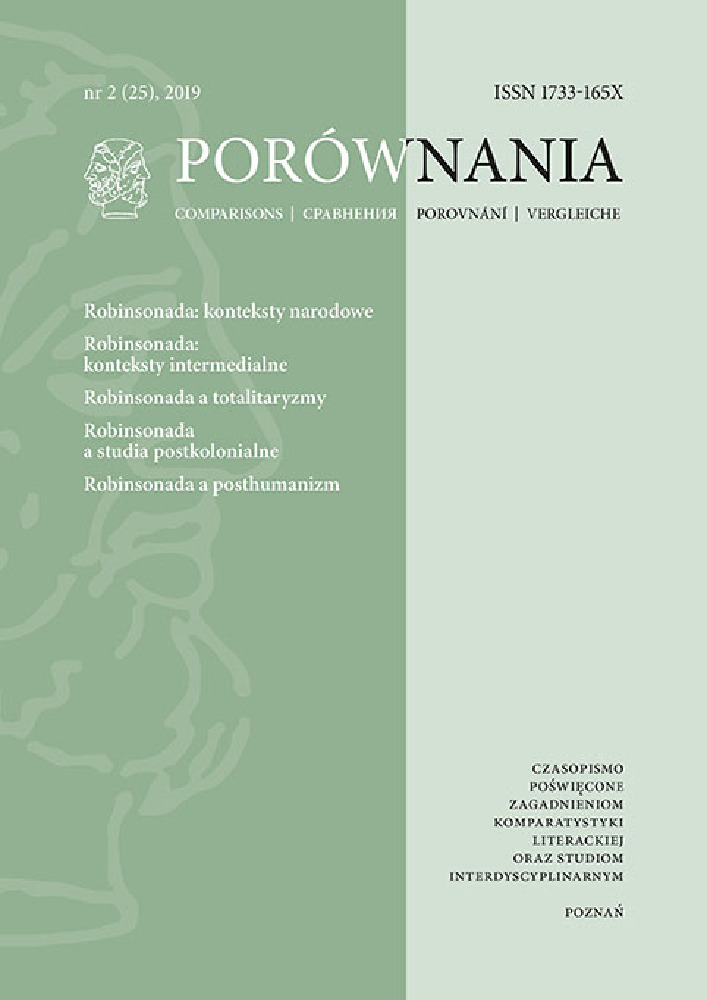Abstrakt
W niniejszym tekście analizie poddane są wybrane ilustracje Thomasa Stotharda przedstawiające wydarzenia z powieści Robinson Crusoe Daniela Defoe. Wyeksponowanie tła naturalnego, wyraźnie widoczne w omawianych ilustracjach, odczytywane jest w kontekście sentymentalnych interpretacji powieści Defoe, które – inaczej niż tekst oryginalny, którego autor wydaje się być nieczuły na piękno natury – zdecydowanie pozytywnie wartościowały samotne życie w harmonii z naturą. Ten aspekt ilustracji Stotharda interpretowany jest w kontekście myśli J. J. Rousseau, a w szczególności tego, jak francuski filozof odczytywał powieść Defoe.
Bibliografia
Allingham, Philip V. “Thomas Stothard’s Robinson Crusoe and Friday making a tent to lodge Friday’s father and the Spaniard”, 2018, Web. 3.02.2020. http://www.victorianweb.org/art/illustration/stothard/19.html.
Bainbridge, Simon (ed.). Romanticism: A Sourcebook. Houndmills: Palgrave Macmillan, 2008.
Baine, Rodney M. “The Evidence from Defoe’s Title Pages”, Studies in Bibliography 25 (1972). 185-191.
Barchas, Janine. Graphic Design, Print Culture, and the Eighteenth-Century Novel. Cambridge: Cambridge University Press, 2003.
Bellhouse, Mary L. “On Understanding Rousseau’s Praise of Robinson Crusoe”, Canadian Journal of Social and Political Theory/Revue canadienne de theorie politique et sociale 6-3 (1982). 120-137.
Blewett, David. The Illustration of Robinson Crusoe, 1719-1920. Gerrards Cross: Smythe, 1995.
Blewett, David. “The Iconic Crusoe: Illustrations and Images of Robinson Crusoe.” In The Cambridge Companion to “Robinson Crusoe.” Edited by John Richetti. Cambridge: Cambridge University Press, 2018. 159-90.
Coetzee, J. M. Foe. London: Penguin Books, 1987.
Defoe, Daniel. The Life and Strange Surprising Adventures of Robinson Crusoe (1719). The Novels of Daniel Defoe. Edited by W. R. Owens and P. N. Furbank. Vol. 1. London: Pickering & Chatto, 2008.
Genette, Gérard. Palimpsests: Literature in the Second Degree, trans. Channa Newman and Claude Doubinsky. Lincoln and London: University of Nebraska Press, 1997.
Genette, Gérard. Paratexts: Thresholds of Interpretation. Cambridge: Cambridge University Press, 1997.
Hagstrum, Jean H. The Sister Arts: The Tradition of Literary Pictorialism and English Poetry from Dryden to Gray. Chicago: University of Chicago Press, 1958.
Hogarth, William. The Analysis of Beauty. Ed. Ronald Paulson. New Haven: Yale University Press, 1997.
Marzec, Robert. An Ecological and Postcolonial Study of Literature: from Daniel Defoe to Salman Rushdie. New York: Palgrave, 2007.
Moszyński, August Fryderyk. Rozprawa o ogrodnictwie angielskim, 1774. Ed. Agnieszka Morawińska. Wrocław: Zakład Narodowy im. Ossolińskich, 1977.
Novak, Maximillian E. Transformations, Ideology, and the Real in Defoe’s Robinson Crusoe and Other Narratives: Finding “The Thing Itself ”. Newark: University of Delaware Press, 2015.
Patten, Robert L. George Cruikshank’s Life, Times, and Art. Volume 1: 1792-1835.
New Brunswick: Rutgers University Press, 1992.
Rousseau, Jean-Jacques. “Julie, or the New Heloise” in The Collected Writings of Rousseau, vol. 6, trans. Philip Stewart and Jean Vaché. Hanover, NH: University Press of New England, 1997.
Rousseau, Jean-Jacques. The Reveries of a Solitary, trans. John Gould Fletcher. New York: Burt Franklin, 1971.
Vickers, Ilse. Defoe and the New Sciences. Cambridge: Cambridge University Press, 1996.
Licencja
Utwory opublikowane w czasopiśmie „Porównania”, na platformie Pressto należącej do Uniwersytetu im. Adama Mickiewicza w Poznaniu są udostępniane na licencji Creative Commons Uznanie autorstwa - Bez utworów zależnych 4.0 Międzynarodowe (CC BY-ND 4.0)
Tym samym wszyscy zainteresowani są uprawnieni do korzystania z utworów opublikowanych pod następującymi warunkami:
-
uznania autorstwa — czyli obowiązek podania wraz z rozpowszechnianym utworem informacji o autorstwie, tytule, źródle (odnośniki do oryginalnego utworu, doi) oraz samej licencji
-
bez utworów zależnych — remiksując, przetwarzając lub tworząc na podstawie utworu, nie wolno rozpowszechniać zmodyfikowanych treści.
-
brak dodatkowych ograniczeń — nie można korzystać ze środków prawnych lub technologicznych, które ograniczają innych w korzystaniu z utworu na warunkach określonych w licencji.
Uniwersytet im. Adama Mickiewicza w Poznaniu zachowuje prawo do czasopisma jako całości (układ, forma graficzna, tytuł, projekt okładki, logo itp.).
Autor zachowuje prawa majątkowe, ale udziela zgody Uniwersytetowi im. Adama Mickiewicza w Poznaniu na wykorzystanie dzieła. Autorzy tekstów zakwalifikowanych do publikacji proszeni są o wypełnienie podpisanie i przesłanie umowa (PL) agreement (EN)
Agreement for granting a royalty-free license to works with a commitment to grant a CC sub-license




